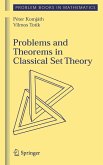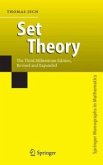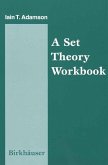What is a number? What is infinity? What is continuity? What is order? Answers to these fundamental questions obtained by late nineteenth-century mathematicians such as Dedekind and Cantor gave birth to set theory. This textbook presents classical set theory in an intuitive but concrete manner.
To allow flexibility of topic selection in courses, the book is organized into four relatively independent parts with distinct mathematical flavors. Part I begins with the Dedekind-Peano axioms and ends with the construction of the real numbers. The core Cantor-Dedekind theory of cardinals, orders, and ordinals appears in Part II. Part III focuses on the real continuum. Finally, foundational issues and formal axioms are introduced in Part IV. Each part ends with a postscript chapter discussing topics beyond the scope of the main text, ranging from philosophical remarks to glimpses into landmark results of modern set theory such as the resolution of Lusin's problems on projective sets using determinacy of infinite games and large cardinals.
Separating the metamathematical issues into an optional fourth part at the end makes this textbook suitable for students interested in any field of mathematics, not just for those planning to specialize in logic or foundations. There is enough material in the text for a year-long course at the upper-undergraduate level. For shorter one-semester or one-quarter courses, a variety of arrangements of topics are possible. The book will be a useful resource for both experts working in a relevant or adjacent area and beginners wanting to learn set theory via self-study.
To allow flexibility of topic selection in courses, the book is organized into four relatively independent parts with distinct mathematical flavors. Part I begins with the Dedekind-Peano axioms and ends with the construction of the real numbers. The core Cantor-Dedekind theory of cardinals, orders, and ordinals appears in Part II. Part III focuses on the real continuum. Finally, foundational issues and formal axioms are introduced in Part IV. Each part ends with a postscript chapter discussing topics beyond the scope of the main text, ranging from philosophical remarks to glimpses into landmark results of modern set theory such as the resolution of Lusin's problems on projective sets using determinacy of infinite games and large cardinals.
Separating the metamathematical issues into an optional fourth part at the end makes this textbook suitable for students interested in any field of mathematics, not just for those planning to specialize in logic or foundations. There is enough material in the text for a year-long course at the upper-undergraduate level. For shorter one-semester or one-quarter courses, a variety of arrangements of topics are possible. The book will be a useful resource for both experts working in a relevant or adjacent area and beginners wanting to learn set theory via self-study.
Dieser Download kann aus rechtlichen Gründen nur mit Rechnungsadresse in A, B, BG, CY, CZ, D, DK, EW, E, FIN, F, GR, HR, H, IRL, I, LT, L, LR, M, NL, PL, P, R, S, SLO, SK ausgeliefert werden.
From the book reviews:
"This book is an excellent introduction to set theory. Dasgupta (Univ. of Detroit Mercy) promotes reader/student interaction by integrating problems throughout the text instead of just providing occasional exercise sets. ... The book contains more than 630 frequently challenging exercises that will interest both upper-division students and readers with strong mathematical backgrounds. Summing Up: Highly Recommended. Upper-division undergraduates and above." (D. P. Turner, Choice, Vol. 52 (6), February, 2015)
"This undergraduate textbook provides a thorough examination of the cardinals, ordinals, and the continuum. ... This work is a good introduction and would serve for two semesters of upper undergraduate study. ... Each part ends with remarks that are a departure point for further exploration. ... The author's clear interest in the subject matter and economy of presentation makes this an effective tool for learning set theory in the lecture hall or through self-study." (Tom Schulte, MAA Reviews, November, 2014)
"The present undergraduate textbook develops the core material on cardinals, ordinals, and the real line in an informal, predominantly intuitive but nevertheless concrete and rigorous manner. ... this lucidly written undergraduate set theory textbook is a welcome addition to the relevant literature, with many individual features and a remarkably high degree of thematic versatility." (Werner Kleinert, zbMATH, Vol. 1286 (2), 2014)
"This book is an excellent introduction to set theory. Dasgupta (Univ. of Detroit Mercy) promotes reader/student interaction by integrating problems throughout the text instead of just providing occasional exercise sets. ... The book contains more than 630 frequently challenging exercises that will interest both upper-division students and readers with strong mathematical backgrounds. Summing Up: Highly Recommended. Upper-division undergraduates and above." (D. P. Turner, Choice, Vol. 52 (6), February, 2015)
"This undergraduate textbook provides a thorough examination of the cardinals, ordinals, and the continuum. ... This work is a good introduction and would serve for two semesters of upper undergraduate study. ... Each part ends with remarks that are a departure point for further exploration. ... The author's clear interest in the subject matter and economy of presentation makes this an effective tool for learning set theory in the lecture hall or through self-study." (Tom Schulte, MAA Reviews, November, 2014)
"The present undergraduate textbook develops the core material on cardinals, ordinals, and the real line in an informal, predominantly intuitive but nevertheless concrete and rigorous manner. ... this lucidly written undergraduate set theory textbook is a welcome addition to the relevant literature, with many individual features and a remarkably high degree of thematic versatility." (Werner Kleinert, zbMATH, Vol. 1286 (2), 2014)









